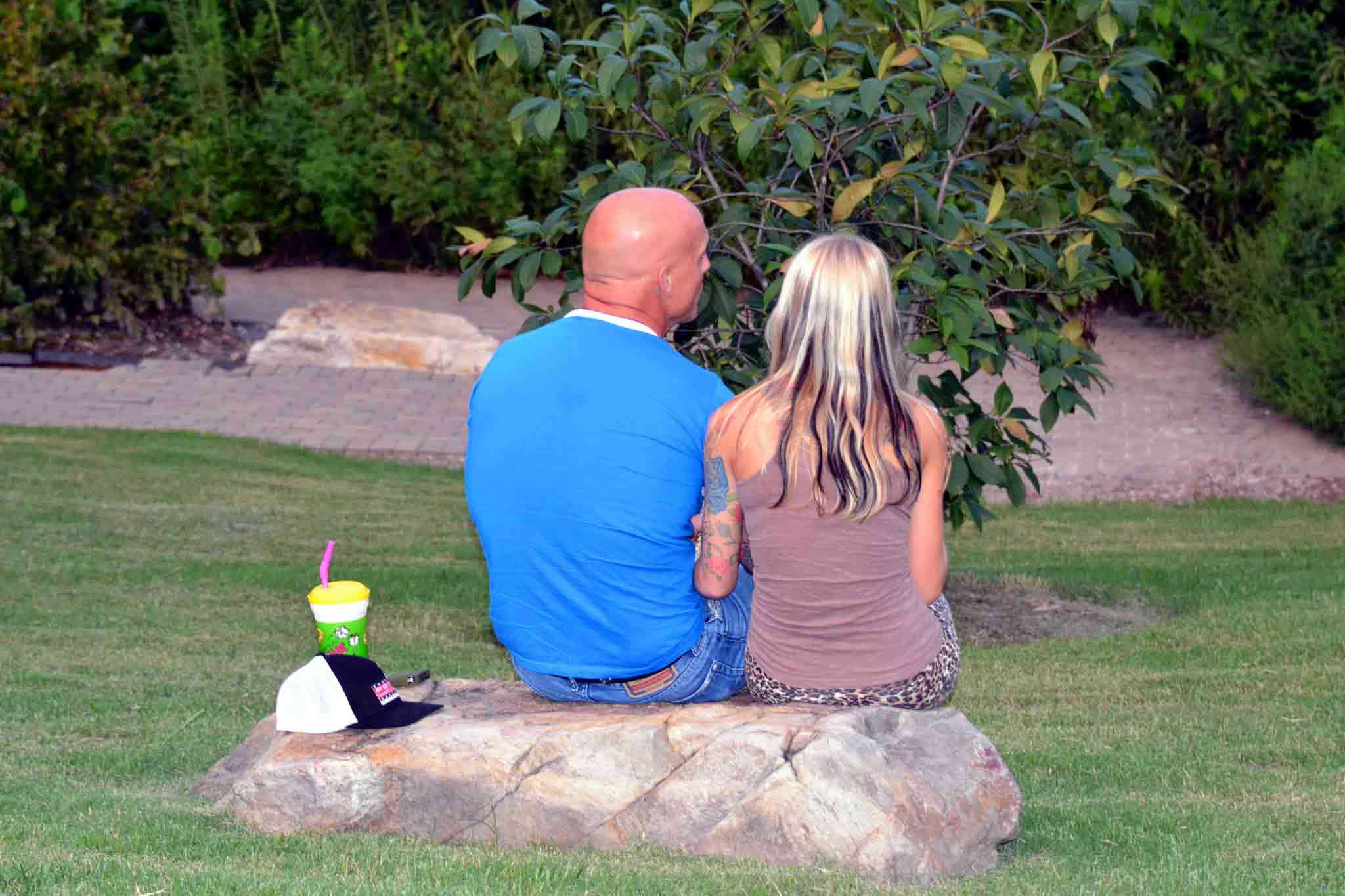Part 2 in a series on the neuroscience of surprise and the weight of wonder. This series explores how raising children up is really the work of growing adults down: grounding and embodying the Self in relationship, integrating the brain and coming out of hiding.
My 4-year-old is hardwired for surprise. This might not be apparent in her favorite game: hide-and-seek.
Because when Taliah was younger, especially, these games ended almost before they began. Often the seeker, eyes closed and counting, was startled by a knee-high tackle from a toddler screaming with delight. Surprise! Taliah had come tearing out of her hiding place if she’d even made it that far.
Her stamina for the game has increased – along with her neural pathways.
 Recently our family was hiking Multnomah Falls outside of Portland, Oregon. The cascading, 630-foot Falls are summited through 13 switchbacks along a steeply routed 1.2-mile trail.
Recently our family was hiking Multnomah Falls outside of Portland, Oregon. The cascading, 630-foot Falls are summited through 13 switchbacks along a steeply routed 1.2-mile trail.
The slow ache of Taliah’s tired little legs soon gathered into a neocortical chorus in her mind. That well-rehearsed refrain we’ve all heard as parents:
“Daaad, are we there yet? Can I ride on your shoulders? Pleeeaase?!”
A tantrum was mounting. And we were only at trail marker 5 of 13. I began bending down towards Taliah, coffee in hand, when in stepped my kind and brilliant wife – who was less caffeinated but more mindfully awake.
“Hey girls, I know it’s hard,” she said to Taliah and her 6-year-old sister, Chloe.
“I can see you’re struggling,” my wife continued, “but I have an idea.”
Playful pause. Her voice dropped to a dramatic whisper.
“Let’s go hide!”
Instantly, the spark returned to Taliah’s eyes. It was as if my wife had found a synaptic match and relit the pilot light in Taliah’s brain. The girls’ sapped legs regained their rubber-band energy – and they took off running up the steep trail.
Within minutes, the treetops were ringing with all the gusto and glory of a forested 4-year-old:
Surprise!
The Surprise Teacher
The brain lives for surprise. Studies show the brain is intrigued by novelty – but that it’s fired even more by the new and unexpected.
 Surprise triggers the brain to release pleasure shots of dopamine, a neurotransmitter that spikes activity in the reward centers of the brain and helps to store new memories. New stimuli are good for a dopamine dump in part because they are processed differently by the brain.
Surprise triggers the brain to release pleasure shots of dopamine, a neurotransmitter that spikes activity in the reward centers of the brain and helps to store new memories. New stimuli are good for a dopamine dump in part because they are processed differently by the brain.
Surprise drives our motivation to adapt and learn. It’s a great teacher, stretching the bounds of our awareness when things go wrong. The how? and why? curiosity it develops inspires us to keep reworking our internalized models and abandoning our outdated assumptions. Surprise paves new neural pathways for more flexible problem-solving and creative thinking.
Surprise as a Safeguard
Surprise also alerts the brain to pay attention, whether for danger or opportunity. It hones observation skills and increases capacity for excitement and wonder – all of which are essential for absorbing information.
By definition, surprise catches us off guard and might even overwhelm us at times. But along with its close cousin, “awe,” surprise ultimately serves to decrease the body’s stress-hormone levels by expanding our window of anxiety tolerance.
Surprise is more than a mood-booster. It also safeguards against the rigid and ruminating thought patterns of the depressed and anxious mind, in part because it attunes us to our surroundings and pulls us into the present moment.
As noted in Part 1, the present moment is not where we usually reside as adults. Children, however, are naturally attuned to surprise.
If we dare to attune to them and how they experience the world, we might just become more aware of ourselves.
Attachment and Autonomy
On the Multnomah trail with our daughter that day, my wife was attuning to a basic neurobiological truth: the brain needs a balance of both safety and surprise. We’ll read more about the safety features of “attunement” in Part 3.
In neurochemical terms, we crave the oxytocin that’s discharged by predictability or safety. But we also relish the dopamine and noradrenaline rush that signals excitement and powers our pinpoint focus during unpredictable events.
Put another way, we need a balance of both attachment (secure connection to others) and autonomy (freedom to explore and make our own way).
Let’s consider how “hide-and-seek” games are meant to integrate safety and surprise. And, how this hiding might sometimes inhibit play instead of spurring it.
Now You See Me
 Hide-and-seek is basically an evolved version of “Peek-a-boo” for infants. These games instill a psychological sense of “object permanence” – the idea that things still exist even if they’re not always seen.
Hide-and-seek is basically an evolved version of “Peek-a-boo” for infants. These games instill a psychological sense of “object permanence” – the idea that things still exist even if they’re not always seen.
What’s nurtured in the child is a deeply felt “knowing” that a parent’s disappearing face will actually return. Tolerating this temporary distress, this dance of “rupture and repair” within the bond of secure attachment, actually reinforces the bond.
The tiny body bracing for the “boo!” becomes suppler as the surprise is absorbed and celebrated. The “reappearance” of a face becomes a sweet reunion that swells the senses for anticipating it again.
How Arousal Drives Personal Growth and Development
This sensory arousal courses through the body, captivates the mind and rivets attention on what’s coming: Will I be found? Will I be seen?
All this “hiding” and “seeking” greases the gears of the brain’s social-emotional learning and its emerging sense of Self. Essentially, it bridges two forms of surprise. It transforms the anxiety of separation into the anticipatory joy of discovery – which expands into the confidence for exploration.
What grows in the gap of surprise is the ability to trust: trusting oneself to bear the tension of waiting and uncertainty and even loss. This creates the capacity to manage turbulent emotional states, endure conflict, and to risk vulnerability for the sake of deeper intimacy in relationship.
Echoes of Eden
Hide-and-seek then is serious play. It’s also a highly ritualized re-enactment of a very ancient story, one so primal that it raises the hair on our necks.
Hide-and-seek holds all the heartache and holiness of our humanity. It bears the very echoes of Eden – the Garden where we were first known and most intimately seen. And, where we suffered our greatest separation. It touches our deepest longings to be found and to be known, and our deepest fears that we might be forever alone and unknown.
The game itself poses God’s question from the Garden after Adam and Eve had tasted the forbidden fruit. If you remember this passage from the Book of Genesis, God is walking through the cool of the day, seeking and calling:
“Where are you?”
Eating from the “tree of knowledge” had opened their eyes to their nakedness, and prompted Adam and Eve to fashion fig-leaf coverings. Now, God’s seeking was driving them further into hiding.
They were more afraid of being exposed than looking forward to being found.
Startled into Hiding
Normally, the threat of being exposed registers not merely as surprise but as a kind of “startle effect.” The body braces for rejection and turns rigid. The face casts down and turns away. Our organs contract, our muscles convulse. The brain dissociates. We begin to detach from our bodies and our deeper Selves.
Shame. Neurobiologists call it the “master emotion,” potentially the most powerful experience we have as humans. We all know shame. For some, it’s an ongoing and overpowering visceral nausea that hits just below the diaphragm. For others, it’s a vague gut-level gnawing that dictates life far more than we realize in the body we fled long ago.
Over time, we learn to retreat behind walls and clenched fists of control. We resort to hiding without seeking, surviving without exploring.
The stress of shame shoves the body into what neuropsychologist Allan Schore describes as an inhibitory state of “energy conservation-withdrawal.” Heart and breathing rates slow, cognitive function is impaired, endorphin output is reduced, and all pleasure pursuits are ceased.
The body constricts and goes numb in a desperate attempt to deflect attention and disappear, Schore says. It seeks to become “unseen.”
In this kind of hiding, the game is lost. And so is one’s sense of Self.
Body Blow: the Physiology of Shame
Shame activates the fear center of the lower emotional brain. Stress hormones are sent cascading through the body, readying it to fight or flee under the threat of exposure. When the threat is perceived as severe (and only the perception matters), the more active fight and flight responses disintegrate into freeze mode.
Shame spirals the body into a helpless and hopeless “infant-distress” state. It rapidly shifts the autonomic nervous system from hyperarousal to hypo-arousal (numbing or freezing) in what’s known as a parasympathetic collapse.
 This trigger will be louder – and take much longer to subside – if we cannot call on our internalized models of safe, loving relationships that infuse an integrated sense of Self.
This trigger will be louder – and take much longer to subside – if we cannot call on our internalized models of safe, loving relationships that infuse an integrated sense of Self.
Without this Self resilience, the brain and body will adapt by normalizing what’s meant to be a temporary survival mode.
In effect, the rational left brain learns to tune out the “startle effect” experienced by the right brain and body-mind. However, the startle will be evident in a strained autonomic nervous system that is still being cued up to respond to a threat that is no longer present but still every bit alive “current” in the body.
Conditioned by shame, the body and brain are forced to maintain a protective hypervigilant state that deactivates the brain’s social-engagement and attachment systems, overrides its language and reasoning centers, and severely compromises the immune system.
Literally, shame is sickening.
Shame and Association
Shame hits core nerves of identity in far deeper ways than “guilt” which can be limited to feeling sorrow for one’s behavior. Shame, unlike guilt, is a regressed, pre-verbal state that diminishes the Self, shuts down the body, and makes it difficult to summon internal resources or signal for outside help.
Shame, whether it’s rooted in traumatic incidents or chronic exposure to subtler emotional abuse and neglect, can have a devastating impact on the brain, body, and psyche.
The body never forgets these moments of terrifying vulnerability, even after the conscious mind has moved on. Often as adults, the current stressors we face are freighted with unconscious associations with the raw, unprocessed, “implicit” memories from our past.
The research here is surprising: What’s most problematic isn’t the incident(s) itself. Rather, it’s how the sticky residue of lingering shame corrupts the psyche – when it’s not fully named and re-processed with supportive others.
We’re now hinting at another neurobiological reality: shame is actually a “pro-social” emotion.
The Corkscrew of Chronic and Toxic Shame
“Pro-social” shame, as it’s intended, has numerous life-preserving functions in mammalian/human societies: it promotes social order, teaches empathy and compassion, stimulates learning, encourages repentance, and renews relationships, to name a few.
The sting of shame, although deeply piercing, is meant to be momentary and temporary. It’s meant to restore us to community.
However, many of us suffer from what psychology refers to as “toxic” or “chronic” shame. We’ve been raised in homes, schools, and churches that were shaming – where shame was subtly and systematically wielded as a tool of socialization, humiliation, and fear-based control.
Shame, when used as a verb, erodes the critical distinction between the person and his or her behavior. Shame loses its proper status as a “social emotion.” Instead, the corkscrew of shame is twisted downward into a Self-preoccupying “me emotion” – I am bad, I am unworthy.
At this level, shame messages and massages our core identity into gross distortions. We are forced to compensate by erecting the “false selves” of survival: we become the people-pleaser, the performer, the loser, the bully.
The issue isn’t simply shame – but unrepaired shame embedded in the psyche.
Ultimately, shame pushes the deeper Self into hiding and into the wilderness.
Body Listening: Hearing the Question
In the passage from the Book of Genesis, where God is strolling through Eden, the question becomes, how do you hear the question?
Imagine God’s voice rustling the leaves on the Garden path. Listen closely to how the Where are you? reverberates in your body. (This means slowing down enough to pay attention.) Is it soft or stern? Do you feel a tone of judgment or suspicion? Disappointment or disapproval?
Are you startled or surprised? Internally, it’s not the same movement.
“Surprise” can expand and integrate the Self – and not just the pleasant surprise of rainbows and birthday celebrations. “Social” shame, experienced as an upsetting revelation or healing conviction, can become the growing pains of contrition and curiosity.
However, unresolved shame is startling. The child’s anticipation that we still carry within – will I be seen? will I be found? – is enough to make us cringe as adults.
Often, we experience this body “cringe” as contempt or disgust or fear, all of which silence the Self’s deeper desire to be known.
Hide and Seek, Hide and Blame
What’s at play here are two different games of hide-and-seek, based on two different experiences – startle and surprise.
The easily startled person has less energy for growth and learning. Unrepaired shame shuts down surprise, wonder, and play because there’s little stress-tolerance available to risk exploration.
In adult relationships and marriage, especially, the creative spirit of “hide and seek” is supplanted by calculated tactics of “hide and blame.”
The hide-and-blame strategy traces back to Adam and Eve in the Garden. He blamed her, she blamed the serpent. And they hid – first from their own nakedness, then from God.
Eden’s question still sends us running: Where are you? We cannot risk being seen. Because we read the Biblical text through the shame-ridden stories of our own life-text, we end up remaking God in our own image: we assume God sees us as we see ourselves.
We struggle to hear a voice of longing and invitation and desire for us. We do not trust the God who covered our shame with animal skins in Eden and with his own life at Golgotha, the God who’s followed us deep into the wilderness in patient pursuit.
Christian Counseling: Coming Out of Hiding
Our body “cringes” need to be found and blessed, because this is the beginning of transformation. The body-mind, withered by shame, is dying for us to remember its core wounding – and to rename it for good.
Later in this series, we’ll explore how to counteract the physiological collapse of shame – through re-posturing the body, re-membering the past, and safely reconnecting with others.
Hiding serves only to safe-harbor our fears, which is not real safety. The fear of exposure loses its grip when we begin holding onto the deeper Self, and to the truths God has revealed about this person.
The person that we most truly are (hidden in God) is also the person that we must risk becoming.
As we’ll see in Part 3, it might surprise you the major role that fairytales play in this process.
With some work, we can step out of shame’s shadow, and re-embody a spirit of discovery and play.
Schore, Allan. (2003). Affect Regulation and the Repair of the Self, New York, NY: W.W. Norton & Company, Inc.
Photos
“Multnomah Falls,” courtesy of Lee Coursey, Flickr CreativeCommons (CC BY 2.0); “Caught You,” courtesy of Rudonl Productions, Flickr CreativeCommons (CC BY-SA 2.0); “You Can’t See Me,” courtesy of mrhayata, Flickr CreativeCommons (CC BY-SA 2.0); “Shame!” courtesy of Mills Baker, Flickr CreativeCommons (CC BY 2.0)






